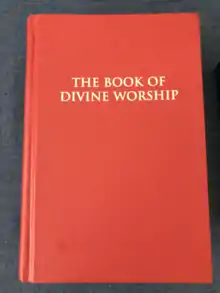Book of Divine Worship
The Book of Divine Worship (BDW) was an adaptation of the American Book of Common Prayer (BCP) by the Catholic Church. It was used primarily by former members of the Episcopal Church within Anglican Use parishes of the Pastoral Provision and the Personal Ordinariates. It has been replaced by a new book to be used worldwide, titled Divine Worship: The Missal.

History
Along with the ordination of married former Episcopal priests, the Pastoral Provision of 1980 permitted the establishment of Anglican Use parishes in the United States and created a special missal using liturgical elements from the Anglican tradition. (Cf. Pope Paul VI, Sacerdotalis caelibatus, no. 42.) This special liturgy was subsequently approved in 1983 by the Vatican's Congregation for Divine Worship and the Committee for the Liturgy of the National Conference of Catholic Bishops. In 2003 it was published in book form as the Book of Divine Worship and the term "Anglican Use" liturgy was applied to it.
When use of the revised English translation of the Novus Ordo Mass went into effect on 27 November 2011, use of the "Rite II" modern language version of the Holy Eucharist in the Book of Divine Worship was suppressed, and parishes had the option of using the "Rite I" traditional language Anglican Use liturgy or conforming to the Novus Ordo liturgy used in parishes not part of the Pastoral Provision.
The Book of Divine Worship in the Eucharistic liturgy by Divine Worship: The Missal, while the Personal Ordinariate of Our Lady of Walsingham and later the Personal Ordinariate of Our Lady of the Southern Cross adopted the Customary of Our Lady of Walsingham as their version of the Anglican Use Divine Office. This latter text was replaced by the Divine Worship: Daily Office in 2020 and 2021.
Design
The Book of Divine Worship contained elements of the 1928 and 1979 American editions of the Book of Common Prayer as well as the 1970 Roman Missal, Missale Romanum.
Offices
It opened with the Calendar of the Church Year used in Anglican Use, followed by the Daily Office lectionary arranged in a two-year cycle. Three readings from Old and New Testaments were provided for each Sunday and weekday in both cycles. The psalms were arranged on a seven-week pattern throughout the year and sung in Anglican Chant. Antiphons—drawn from the psalms, from the opening sentences in the Offices or from scriptural passages—were used with the psalms or canticles.
There was Morning and Evening Prayer, in traditional and modern English, along with a Midday Office and Compline. The structure of these Offices was antiphon and psalmody; Old and New Testament lessons, each followed by a canticle; Apostles Creed; Lord's Prayer, Preces, and collects. The Litany, in traditional English, echoed the Great Litany, with some additional petitions to the Virgin Mary and the Saints.
Mass
The Proper of the Mass included the appointed Introit, Collect, Gradual, Alleluia or Tract, Offertory, and Communion. The Epistle and Gospel readings for Sunday were to be taken from the Revised Roman Missal. There were optional rubrics before each rite.
The Ordinary of the Mass was very much the same as in the Roman Rite and the 1979 Book of Common Prayer, with the Kyrie eleison, Gloria in excelsis, Credo, Sanctus - Benedictus, and Agnus Dei. The Canon used was the Eucharistic Prayer I from the present Latin Rite Mass.
End-of-life
The Book of Divine Worship was seen as US-centric and was not used in parishes of the Personal Ordinariates outside the US, but was instrumental in the joint development of a new liturgy by the Interdicasterial Commission Anglicanae Traditiones of the Congregation for the Doctrine of the Faith and the Congregation for Divine Worship and the Discipline of the Sacraments to be the traditional language liturgy for all Ordinariate parishes worldwide as called for by the apostolic constitution Anglicanorum Coetibus of 4 November 2009.[1] Beginning in 2013, as Pastoral Provision aka Anglican Use parishes in the United States migrated from their geographic dioceses into the Ordinariate and as new parishes were established within the Ordinariate, any parishes using the Book of Divine Worship transitioned to the new ordinariate liturgy. As of November 2015 all but two Anglican Use parishes had migrated from their local diocese into the Ordinariate and use of the Book of Divine Worship for the Holy Eucharist had almost entirely ceased. As of 1 January 2016, the Vatican withdrew permission for use of the book in public worship.
On Advent Sunday 2015 (29 November 2015) the new missal for the Ordinariates, Divine Worship: The Missal[2] went into effect. Ordinariate parishes now use this new missal as their traditional language liturgy and the Post-Vatican II Mass when they prefer to use modern language.
As for the liturgies other than the Eucharist contained in the Book of Divine Worship, the Ordinariates had previously issued their own editions of the pastoral offices of Holy Baptism, Confirmation, Holy Matrimony, and Burial of the Dead and are also preparing a new edition of the Divine Offices of Morning Prayer, Evensong, and the minor offices.
See also
- Pastoral Provision
- Personal Ordinariate
- Anglican Use
- Daily Office
- Book of Common Prayer
- Roman Missal
- Anglican chant
References
- In the Annuario Pontificio such structures are listed under the heading "Personal Ordinariates" followed, in small print, by "in accordance with the Apostolic Constitution Anglicanorum coetibus, 4 November 2009" (Annuario Pontificio 2012, Libreria Editrice Vaticana 2012 ISBN 978-88-209-8722-0, p. 1034).
- ISBN 978-1-78469-020-5, Catholic Truth Society